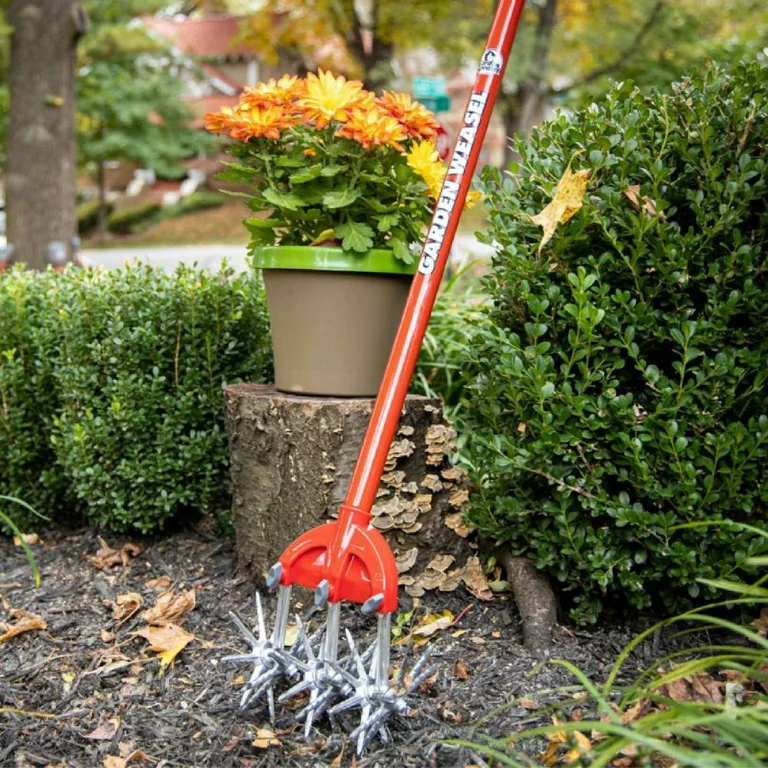
Essential Landscaping Tools: Crafting the Perfect Outdoor Space
The Foundation of Landscaping Success
Landscaping tools form the backbone of any successful outdoor project. Quality equipment makes tasks easier and more efficient. The right tools can transform a daunting project into a manageable endeavor. Professionals and homeowners alike rely on a core set of landscaping implements. These tools range from simple hand-held devices to more complex machinery. Investing in proper equipment pays dividends in the long run. It ensures better results and saves time on outdoor projects. A well-stocked tool shed becomes an invaluable asset for any landscaper.
Hand Tools: The Essentials for Every Gardener
Hand tools remain indispensable in landscaping work. Shovels come in various shapes for different digging tasks. Trowels offer precision for planting and weeding in tight spaces. Pruning shears keep plants trimmed and healthy. Rakes help in clearing debris and leveling soil. Hand cultivators loosen soil and remove weeds effectively. Hoes aid in creating furrows and managing weeds between rows. Garden forks excel at turning soil and harvesting root crops. These tools provide direct interaction with the earth and plants. Their simplicity belies their importance in landscaping work. Proper care extends the life of these essential implements.
Power Tools: Amplifying Landscaping Capabilities
Power tools significantly enhance landscaping efficiency and capability. Lawnmowers form the cornerstone of turf maintenance. String trimmers tackle grass in hard-to-reach areas. Hedge trimmers shape bushes and maintain formal gardens. Leaf blowers quickly clear large areas of debris. Chainsaws handle tree trimming and removal tasks. Power edgers create clean lines between lawns and hardscapes. Tillers prepare large areas of soil for planting. These tools save time and energy on larger properties. They enable landscapers to tackle more ambitious projects. Proper training ensures safe and effective use of power equipment.
Watering Equipment: Nurturing Green Spaces
Watering tools play a crucial role in landscape maintenance. Hoses provide flexible water delivery across the yard. Sprinklers offer automated watering for lawns and gardens. Watering cans allow precise control for delicate plants. Drip irrigation systems conserve water in arid climates. Soaker hoses deliver water directly to plant roots. Rain barrels collect and store rainwater for later use. Moisture meters help determine when watering is necessary. Proper watering equipment ensures plant health and vitality. It also promotes water conservation in landscaping practices. Efficient irrigation saves both resources and money over time.
Soil Working Tools: Preparing the Ground for Growth
Soil preparation tools lay the groundwork for successful planting. Tillers break up compacted soil efficiently. Cultivators mix amendments into existing soil. Soil scoops measure and transport soil and mulch. Bulb planters create perfect holes for spring-flowering bulbs. Dibbers make precise planting holes for seeds and seedlings. Soil knives cut through roots and perform various tasks. Soil testing kits analyze nutrient levels and pH. These tools improve soil structure and fertility. They create optimal growing conditions for plants. Proper soil preparation leads to healthier, more vibrant landscapes.
Hauling and Transportation Tools: Moving Materials with Ease
Landscaping often involves moving heavy materials around the property. Wheelbarrows transport soil, mulch, and plants efficiently. Garden carts offer stability for heavier loads. Tarps protect surfaces and aid in debris collection. Folding wagons provide versatility for various hauling tasks. Lifting straps help move heavy objects safely. Hand trucks navigate narrow spaces with bulky items. These tools reduce physical strain on landscapers. They increase productivity by minimizing trips. Proper hauling equipment makes large projects more manageable. It also reduces the risk of injury from heavy lifting.
Specialty Tools: Addressing Unique Landscaping Challenges
Certain landscaping tasks require specialized tools for best results. Aerators improve soil drainage and reduce compaction. Dethatchers remove dead grass and promote healthy growth. Edgers create clean lines between different landscape elements. Root feeders deliver nutrients directly to tree roots. Grass seeders ensure even distribution when planting lawns. Leaf vacuums collect and mulch fallen leaves efficiently. These tools address specific landscaping needs. They enhance the overall quality of outdoor spaces. Specialty tools often make the difference in professional-looking results. They allow landscapers to tackle complex projects with confidence.
Safety Equipment: Protecting the Landscaper
Safety gear is crucial when working with landscaping tools. Gloves protect hands from blisters, cuts, and chemicals. Safety glasses shield eyes from debris and flying objects. Ear protection reduces the risk of hearing damage from loud equipment. Steel-toed boots guard against falling objects and provide stability. Sun protection, including hats and sunscreen, prevents sunburn and heat exhaustion. Respirators safeguard against dust and chemical fumes. Proper safety equipment prevents accidents and injuries. It allows landscapers to work comfortably and confidently. Prioritizing safety ensures long-term success in landscaping endeavors.
Maintenance Tools: Keeping Equipment in Top Shape
Tool maintenance equipment preserves the functionality of landscaping implements. Sharpening stones keep blades and edges effective. Cleaning brushes remove dirt and debris from tools. Lubricating oils prevent rust and ensure smooth operation. Replacement parts extend the life of well-used tools. Storage racks organize tools and protect them from damage. Tool belts and aprons keep frequently used items close at hand. Regular maintenance prolongs the life of landscaping equipment. It ensures tools perform optimally when needed. Proper care of tools represents a sound investment in landscaping success.
Measuring and Layout Tools: Achieving Precision in Design
Accurate measurements are essential for successful landscaping projects. Tape measures provide basic linear measurements. Laser levels ensure straight lines and consistent grades. Marking flags delineate planting areas and utility lines. Measuring wheels calculate distances over uneven terrain. Compass tools aid in orienting garden designs. Graph paper helps in creating scaled landscape plans. These tools bring precision to landscape design and implementation. They help translate ideas from concept to reality. Accurate measurements prevent costly mistakes in material purchases and installations. Proper layout ensures harmonious and functional outdoor spaces.
Planting Tools: Nurturing New Growth
Specific tools cater to the needs of planting and transplanting. Dibbers create precise holes for seeds and small plants. Bulb planters make quick work of spring bulb installations. Root pruners prepare plants for successful transplanting. Plant caddies move heavy potted plants with ease. Tree stakes support newly planted trees against wind. These tools facilitate successful plant establishment. They minimize stress on plants during the planting process. Proper planting techniques lead to healthier, more vigorous plant growth. The right tools make the planting process more efficient and effective.
Pruning and Trimming Tools: Shaping the Landscape
Pruning tools maintain plant health and shape the landscape’s appearance. Bypass pruners make clean cuts on live stems and branches. Anvil pruners work well for dead or woody growth. Loppers handle thicker branches beyond the capacity of hand pruners. Pole pruners reach high branches without a ladder. Hedge shears shape formal hedges and topiaries. These tools control plant growth and promote healthy development. Regular pruning improves plant appearance and productivity. Proper pruning techniques require the right tools for each task. Well-maintained pruning tools ensure clean cuts and prevent plant damage.
Hardscaping Tools: Building Structural Elements
Hardscaping projects require a specific set of tools for working with non-living landscape elements. Mason’s trowels spread mortar for brick and stone work. Levels ensure flat surfaces in patios and walkways. Tampers compact soil and gravel for stable foundations. Brick hammers shape and split hard materials. Edging tools create clean lines between hardscapes and softscapes. These tools facilitate the creation of durable landscape structures. They allow for precise installation of pavers, retaining walls, and other features. Quality hardscaping tools result in professional-looking, long-lasting outdoor elements.
Lawn Care Tools: Maintaining Lush Turf
A healthy lawn requires regular maintenance with specialized tools. Reel mowers provide a clean cut for small, level lawns. Rotary mowers handle larger areas and varied terrain efficiently. Grass catchers collect clippings for a neat appearance. Edgers create crisp boundaries along sidewalks and driveways. Dethatchers remove dead grass and promote healthy growth. Spreaders distribute fertilizer and seed evenly. These tools contribute to a lush, well-manicured lawn. Regular use maintains turf health and appearance. Proper lawn care tools make routine maintenance more manageable and effective.

Seasonal Tools: Adapting to Changing Landscape Needs
Different seasons bring unique landscaping challenges and requirements. Snow shovels and blowers clear winter precipitation. Leaf rakes and blowers manage autumn foliage. Pruning tools see heavy use in late winter and early spring. Planting tools come to the forefront in spring and fall. Watering equipment becomes crucial in hot summer months. Seasonal tools help landscapers adapt to changing conditions. They allow for year-round landscape maintenance and improvement. Investing in season-specific tools ensures preparedness for various weather conditions. Proper seasonal maintenance keeps landscapes looking their best throughout the year.
Eco-Friendly Landscaping Tools: Sustainability in Practice
Environmentally conscious landscaping calls for tools that minimize ecological impact. Manual tools reduce reliance on fossil fuels. Electric-powered equipment offers a cleaner alternative to gas engines. Drip irrigation systems conserve water in garden beds. Compost bins turn yard waste into valuable soil amendments. Rain barrels collect rainwater for irrigation use. These tools promote sustainable landscaping practices. They reduce the carbon footprint of outdoor maintenance. Eco-friendly tools often provide long-term cost savings. They align landscaping practices with environmental stewardship goals.
Conclusion: The Right Tools for Beautiful Landscapes
Quality landscaping tools form the foundation of successful outdoor projects. From simple hand tools to specialized power equipment, each implement serves a vital purpose. Proper tool selection enhances efficiency and results in landscaping work. Regular maintenance ensures tools remain effective for years to come. Investing in a comprehensive set of landscaping tools pays dividends in the long run. It enables the creation and maintenance of beautiful, functional outdoor spaces. With the right tools at hand, any landscape vision can become a reality. Landscaping tools transform outdoor work from a chore into a rewarding endeavor.



